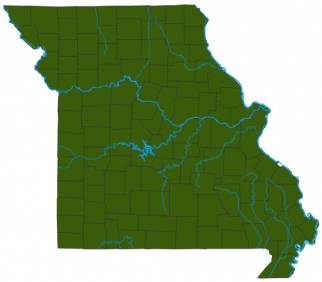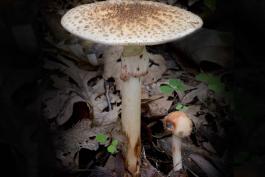
Tan to reddish brown cap with pinkish brown patches and a ring on the stalk; the entire mushroom bruises reddish. Grows on the ground in oak woods and under white pines. June–October. Cap convex to almost flat; tan to reddish brown with pinkish brown patches, bruising reddish; texture smooth with cottony patches, slightly tacky when wet. Gills moderately broad; spacing close to crowded; whitish, bruising reddish to reddish brown, often quickly; attachment free or slightly attached. Stalk enlarges toward the base, which is large, soft, and bulbous; whitish, bruising pink to red; texture smooth to fibrous; has a ring. Universal veil grayish to gray-pink, leaving pinkish brown patches on the cap. Partial veil whitish, staining pinkish, and leaving a skirtlike ring on the upper stalk. Spore print white. Spores magnified are elliptical, smooth.
Lookalikes: Other Amanita species.
Cap width: 2–6 inches; stalk length: 3–8 inches; stalk width: ¼–¾ inch.

Statewide.
Habitat and Conservation
Grows on the ground in oak woods and under white pines. Named for its rather quick bruising when damaged, the blusher is a very common Missouri mushroom. However, researchers believe that at least some of the mushrooms we call "Amanita rubescens" in North America are really not the same mushroom as in other parts of the world. It may soon be given a new Latin name.
Status
Not recommended. Though this is an edible mushroom, it could too easily be mistaken for one of the deadly Amanita species.
Life Cycle
This species is mycorrhizal: It exists most of the time as a network of cells (mycelium) connected to tree roots, in a symbiotic relationship with the tree. (Many trees fare poorly without their fungal partners.) When ready to reproduce, the mycelium sends up the mushroom aboveground—this is the reproductive structure. Spores are produced in these structures and are released to begin new mycelia elsewhere. The mycelium of a mushroom can live for decades.
Human Connections
Many inedible and even poisonous fungi have important roles in nature, benefiting humans indirectly by keeping forests productive and healthy. They each also possess a strange beauty in color and form that humans can enjoy.
Ecosystem Connections
This is one of the many fungus species that help nourish forest trees through a symbiotic connection with tree roots. Netlike fibers, called the mycelium, increase the roots' ability to absorb water and nutrients. In return, the tree shares nutrients with the fungus.


Mushrooms are a lot like plants, but they lack chlorophyll and have to take nutrients from other materials. Mushrooms are neither plants nor animals. They are in a different kingdom — the fungi. Fungi include the familiar mushroom-forming species, plus the yeasts, molds, smuts, and rusts.
Always be cautious when eating edible mushrooms. Be absolutely sure of the ID, and only eat a small amount the first time you try it to avoid a reaction..





















